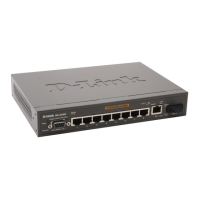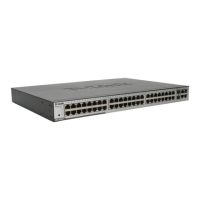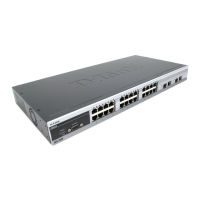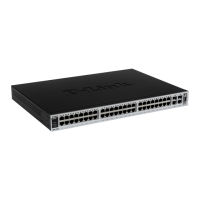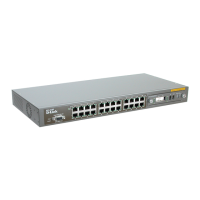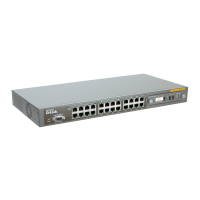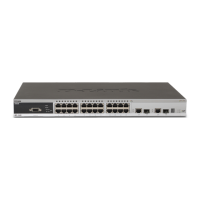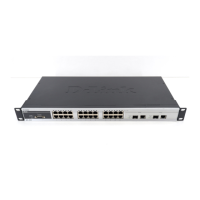Do you have a question about the D-Link DES-3010FA and is the answer not in the manual?
Instructions for desktop/shelf installation and rack mounting of the device.
Steps for connecting the switch to a terminal and establishing AC power connection.
Procedure for booting the device, including default login information and POST messages.
Details on dynamic IP allocation (DHCP/BOOTP) and security management (AAA).
Procedures for using the startup menu, software download, and password recovery.
Procedure for resetting the device to its default configuration from a remote location.
Settings for managing device security, including authentication methods and passwords.
Management of network security features like access control lists, port locking, and traffic control.
Defining port parameters such as speed, duplex mode, auto-negotiation, and MDI/MDIX.
Configuration of Link Aggregated Groups (LAGs) for increased bandwidth and port flexibility.
Settings for Link Aggregation Control Protocol (LACP) to automatically establish aggregated links.
Configuration of VLAN properties, including VLAN ID, Name, Type, and Authentication settings.
Mapping VLAN parameters to ports and assigning VLAN membership.
Configuration of port modes (General, Access, Trunk) and VLAN settings for interfaces.
Configuration of IP parameters for interfaces, including IP addresses, default gateways, DHCP, and ARP.
Configuration of static MAC address entries in the forwarding database.
Configuration and enabling of Classic Spanning Tree Protocol (STP) on the device.
Assignment of STP settings to specific interfaces, including port states and roles.
Configuration and enabling of Rapid Spanning Tree Protocol (RSTP) for faster STP convergence.
Configuration of Multiple Spanning Tree Protocol (MSTP) for load balancing scenarios.
Configuration of SNMP security parameters, including Engine ID, views, group profiles, and communities.
Instructions for desktop/shelf installation and rack mounting of the device.
Steps for connecting the switch to a terminal and establishing AC power connection.
Procedure for booting the device, including default login information and POST messages.
Details on dynamic IP allocation (DHCP/BOOTP) and security management (AAA).
Procedures for using the startup menu, software download, and password recovery.
Procedure for resetting the device to its default configuration from a remote location.
Settings for managing device security, including authentication methods and passwords.
Management of network security features like access control lists, port locking, and traffic control.
Defining port parameters such as speed, duplex mode, auto-negotiation, and MDI/MDIX.
Configuration of Link Aggregated Groups (LAGs) for increased bandwidth and port flexibility.
Settings for Link Aggregation Control Protocol (LACP) to automatically establish aggregated links.
Configuration of VLAN properties, including VLAN ID, Name, Type, and Authentication settings.
Mapping VLAN parameters to ports and assigning VLAN membership.
Configuration of port modes (General, Access, Trunk) and VLAN settings for interfaces.
Configuration of IP parameters for interfaces, including IP addresses, default gateways, DHCP, and ARP.
Configuration of static MAC address entries in the forwarding database.
Configuration and enabling of Classic Spanning Tree Protocol (STP) on the device.
Assignment of STP settings to specific interfaces, including port states and roles.
Configuration and enabling of Rapid Spanning Tree Protocol (RSTP) for faster STP convergence.
Configuration of Multiple Spanning Tree Protocol (MSTP) for load balancing scenarios.
Configuration of SNMP security parameters, including Engine ID, views, group profiles, and communities.
